Hiroya Takamura
Building Instruction-Tuning Datasets from Human-Written Instructions with Open-Weight Large Language Models
Mar 31, 2025Abstract:Instruction tuning is crucial for enabling Large Language Models (LLMs) to solve real-world tasks. Prior work has shown the effectiveness of instruction-tuning data synthesized solely from LLMs, raising a fundamental question: Do we still need human-originated signals for instruction tuning? This work answers the question affirmatively: we build state-of-the-art instruction-tuning datasets sourced from human-written instructions, by simply pairing them with LLM-generated responses. LLMs fine-tuned on our datasets consistently outperform those fine-tuned on existing ones. Our data construction approach can be easily adapted to other languages; we build datasets for Japanese and confirm that LLMs tuned with our data reach state-of-the-art performance. Analyses suggest that instruction-tuning in a new language allows LLMs to follow instructions, while the tuned models exhibit a notable lack of culture-specific knowledge in that language. The datasets and fine-tuned models will be publicly available. Our datasets, synthesized with open-weight LLMs, are openly distributed under permissive licenses, allowing for diverse use cases.
AdParaphrase: Paraphrase Dataset for Analyzing Linguistic Features toward Generating Attractive Ad Texts
Feb 07, 2025Abstract:Effective linguistic choices that attract potential customers play crucial roles in advertising success. This study aims to explore the linguistic features of ad texts that influence human preferences. Although the creation of attractive ad texts is an active area of research, progress in understanding the specific linguistic features that affect attractiveness is hindered by several obstacles. First, human preferences are complex and influenced by multiple factors, including their content, such as brand names, and their linguistic styles, making analysis challenging. Second, publicly available ad text datasets that include human preferences are lacking, such as ad performance metrics and human feedback, which reflect people's interests. To address these problems, we present AdParaphrase, a paraphrase dataset that contains human preferences for pairs of ad texts that are semantically equivalent but differ in terms of wording and style. This dataset allows for preference analysis that focuses on the differences in linguistic features. Our analysis revealed that ad texts preferred by human judges have higher fluency, longer length, more nouns, and use of bracket symbols. Furthermore, we demonstrate that an ad text-generation model that considers these findings significantly improves the attractiveness of a given text. The dataset is publicly available at: https://github.com/CyberAgentAILab/AdParaphrase.
Analyzing Continuous Semantic Shifts with Diachronic Word Similarity Matrices
Jan 16, 2025



Abstract:The meanings and relationships of words shift over time. This phenomenon is referred to as semantic shift.Research focused on understanding how semantic shifts occur over multiple time periods is essential for gaining a detailed understanding of semantic shifts.However, detecting change points only between adjacent time periods is insufficient for analyzing detailed semantic shifts, and using BERT-based methods to examine word sense proportions incurs a high computational cost.To address those issues, we propose a simple yet intuitive framework for how semantic shifts occur over multiple time periods by leveraging a similarity matrix between the embeddings of the same word through time.We compute a diachronic word similarity matrix using fast and lightweight word embeddings across arbitrary time periods, making it deeper to analyze continuous semantic shifts.Additionally, by clustering the similarity matrices for different words, we can categorize words that exhibit similar behavior of semantic shift in an unsupervised manner.
Why We Build Local Large Language Models: An Observational Analysis from 35 Japanese and Multilingual LLMs
Dec 19, 2024



Abstract:Why do we build local large language models (LLMs)? What should a local LLM learn from the target language? Which abilities can be transferred from other languages? Do language-specific scaling laws exist? To explore these research questions, we evaluated 35 Japanese, English, and multilingual LLMs on 19 evaluation benchmarks for Japanese and English, taking Japanese as a local language. Adopting an observational approach, we analyzed correlations of benchmark scores, and conducted principal component analysis (PCA) on the scores to derive \textit{ability factors} of local LLMs. We found that training on English text can improve the scores of academic subjects in Japanese (JMMLU). In addition, it is unnecessary to specifically train on Japanese text to enhance abilities for solving Japanese code generation, arithmetic reasoning, commonsense, and reading comprehension tasks. In contrast, training on Japanese text could improve question-answering tasks about Japanese knowledge and English-Japanese translation, which indicates that abilities for solving these two tasks can be regarded as \textit{Japanese abilities} for LLMs. Furthermore, we confirmed that the Japanese abilities scale with the computational budget for Japanese text.
GADFA: Generator-Assisted Decision-Focused Approach for Opinion Expressing Timing Identification
Oct 02, 2024

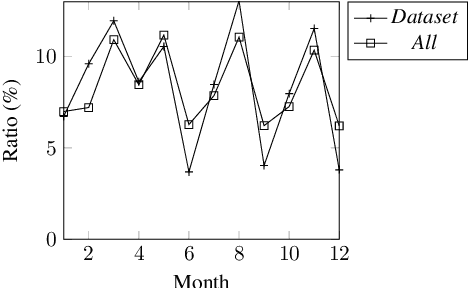
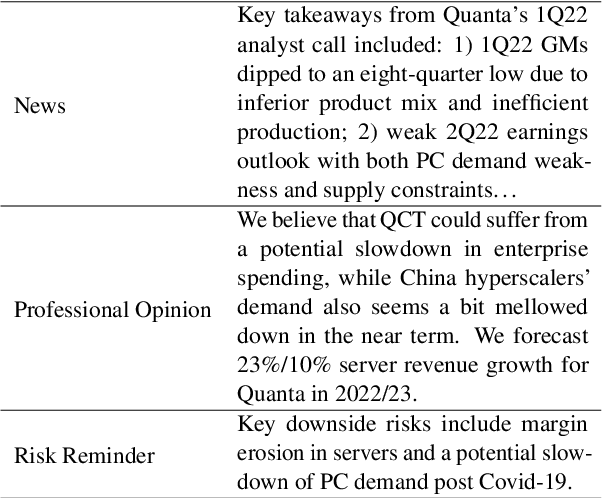
Abstract:The advancement of text generation models has granted us the capability to produce coherent and convincing text on demand. Yet, in real-life circumstances, individuals do not continuously generate text or voice their opinions. For instance, consumers pen product reviews after weighing the merits and demerits of a product, and professional analysts issue reports following significant news releases. In essence, opinion expression is typically prompted by particular reasons or signals. Despite long-standing developments in opinion mining, the appropriate timing for expressing an opinion remains largely unexplored. To address this deficit, our study introduces an innovative task - the identification of news-triggered opinion expressing timing. We ground this task in the actions of professional stock analysts and develop a novel dataset for investigation. Our approach is decision-focused, leveraging text generation models to steer the classification model, thus enhancing overall performance. Our experimental findings demonstrate that the text generated by our model contributes fresh insights from various angles, effectively aiding in identifying the optimal timing for opinion expression.
Rehearsing Answers to Probable Questions with Perspective-Taking
Sep 27, 2024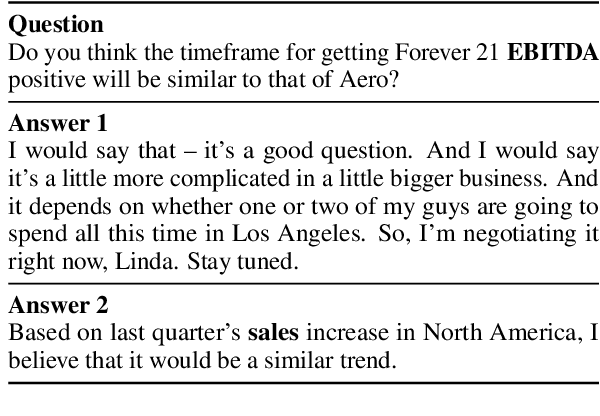

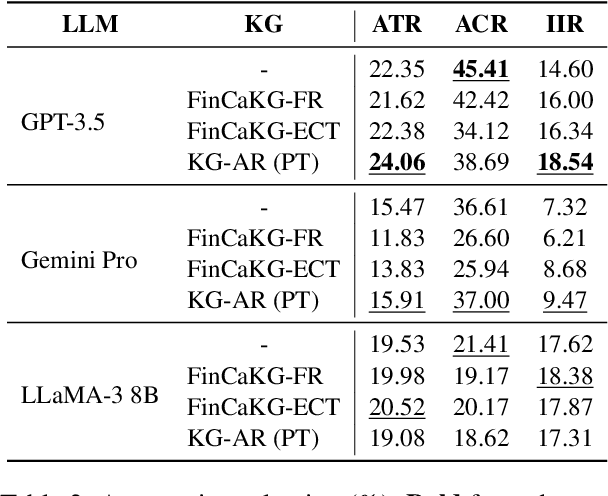
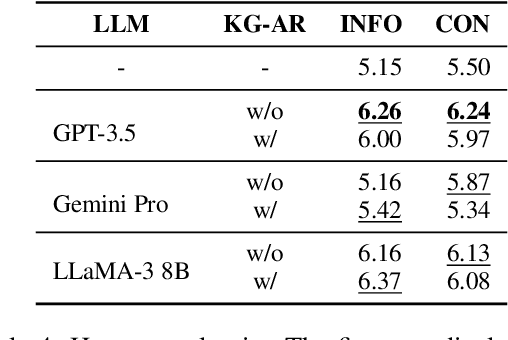
Abstract:Question answering (QA) has been a long-standing focus in the NLP field, predominantly addressing reading comprehension and common sense QA. However, scenarios involving the preparation of answers to probable questions during professional oral presentations remain underexplored. In this paper, we pioneer the examination of this crucial yet overlooked topic by utilizing real-world QA conversation transcripts between company managers and professional analysts. We explore the proposed task using three causal knowledge graphs (KGs) and three large language models (LLMs). This work provides foundational insights into the application of LLMs in professional QA scenarios, highlighting the importance of causal KGs and perspective-taking in generating effective responses.
Enhancing Financial Sentiment Analysis with Expert-Designed Hint
Sep 26, 2024



Abstract:This paper investigates the role of expert-designed hint in enhancing sentiment analysis on financial social media posts. We explore the capability of large language models (LLMs) to empathize with writer perspectives and analyze sentiments. Our findings reveal that expert-designed hint, i.e., pointing out the importance of numbers, significantly improve performances across various LLMs, particularly in cases requiring perspective-taking skills. Further analysis on tweets containing different types of numerical data demonstrates that the inclusion of expert-designed hint leads to notable improvements in sentiment analysis performance, especially for tweets with monetary-related numbers. Our findings contribute to the ongoing discussion on the applicability of Theory of Mind in NLP and open new avenues for improving sentiment analysis in financial domains through the strategic use of expert knowledge.
Enhancing Investment Opinion Ranking through Argument-Based Sentiment Analysis
Sep 25, 2024
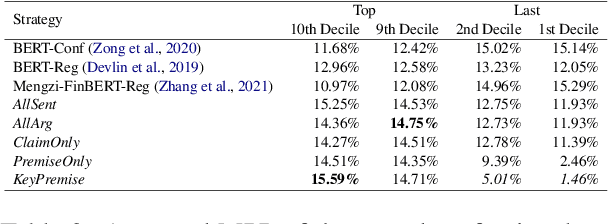


Abstract:In the era of rapid Internet and social media platform development, individuals readily share their viewpoints online. The overwhelming quantity of these posts renders comprehensive analysis impractical. This necessitates an efficient recommendation system to filter and present significant, relevant opinions. Our research introduces a dual-pronged argument mining technique to improve recommendation system effectiveness, considering both professional and amateur investor perspectives. Our first strategy involves using the discrepancy between target and closing prices as an opinion indicator. The second strategy applies argument mining principles to score investors' opinions, subsequently ranking them by these scores. Experimental results confirm the effectiveness of our approach, demonstrating its ability to identify opinions with higher profit potential. Beyond profitability, our research extends to risk analysis, examining the relationship between recommended opinions and investor behaviors. This offers a holistic view of potential outcomes following the adoption of these recommended opinions.
Beyond Turing Test: Can GPT-4 Sway Experts' Decisions?
Sep 25, 2024Abstract:In the post-Turing era, evaluating large language models (LLMs) involves assessing generated text based on readers' reactions rather than merely its indistinguishability from human-produced content. This paper explores how LLM-generated text impacts readers' decisions, focusing on both amateur and expert audiences. Our findings indicate that GPT-4 can generate persuasive analyses affecting the decisions of both amateurs and professionals. Furthermore, we evaluate the generated text from the aspects of grammar, convincingness, logical coherence, and usefulness. The results highlight a high correlation between real-world evaluation through audience reactions and the current multi-dimensional evaluators commonly used for generative models. Overall, this paper shows the potential and risk of using generated text to sway human decisions and also points out a new direction for evaluating generated text, i.e., leveraging the reactions and decisions of readers. We release our dataset to assist future research.
FinGen: A Dataset for Argument Generation in Finance
May 31, 2024



Abstract:Thinking about the future is one of the important activities that people do in daily life. Futurists also pay a lot of effort into figuring out possible scenarios for the future. We argue that the exploration of this direction is still in an early stage in the NLP research. To this end, we propose three argument generation tasks in the financial application scenario. Our experimental results show these tasks are still big challenges for representative generation models. Based on our empirical results, we further point out several unresolved issues and challenges in this research direction.
 Add to Chrome
Add to Chrome Add to Firefox
Add to Firefox Add to Edge
Add to Edge